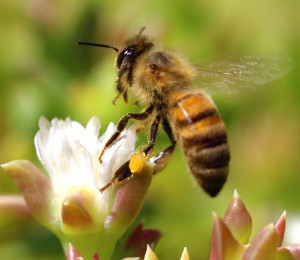01
Jun
EPA’s “New” Restrictions Fail to Protect Honey Bees as Promised
(Beyond Pesticides, June 1, 2015) Last week, the Environmental Protection Agency (EPA) released a proposal intended to create “physical and temporal space” between bees and toxic pesticides. While touted as monumental progress on bee health by the agency, the reality is that the proposal will only result in modest changes to pesticide labels. EPA’s new rules contain only a temporary ban on foliar applications of acutely bee-toxic pesticide products, including neonicotinoid class insecticides, during bloom and when a beekeeper is on site and under contract. The proposal doesn’t address the widespread contamination and detrimental effects of these toxic, systemic (whole plant poisons) chemicals that will continue to occur even during the temporary prohibition.
 Media reports have generally overstated the implications of the proposal, applauding the “new” restrictions, and labeling the small portion of agricultural land that is affected as “pesticide-free zones,” which couldn’t be further from the truth. The restrictions are not anything new — EPA pesticide labels already prohibit applications while in bloom where bees are foraging. Neal Bergman, a commercial beekeeper in Missouri, said in a statement to the St. Louis Post-Dispatch that the proposal is “basically enforcing label guidelines,” further highlighting the fact that EPA has failed to protect bees in the past. EPA did make one label change that eliminated the 48-hour rule exception, which previously allowed foliar application of pesticides while honey bees were on the property, as long as bee keepers were given notice no less than 48 hours in advance. Unfortunately, this minor label change won’t stop the widespread contamination of landscapes or prevent harm associated with systemic neonicotinoids. These dangerous pesticides have been linked to the global disappearance of honey bees and other non-target organisms, such as earthworms, birds, and aquatic invertebrates.
Media reports have generally overstated the implications of the proposal, applauding the “new” restrictions, and labeling the small portion of agricultural land that is affected as “pesticide-free zones,” which couldn’t be further from the truth. The restrictions are not anything new — EPA pesticide labels already prohibit applications while in bloom where bees are foraging. Neal Bergman, a commercial beekeeper in Missouri, said in a statement to the St. Louis Post-Dispatch that the proposal is “basically enforcing label guidelines,” further highlighting the fact that EPA has failed to protect bees in the past. EPA did make one label change that eliminated the 48-hour rule exception, which previously allowed foliar application of pesticides while honey bees were on the property, as long as bee keepers were given notice no less than 48 hours in advance. Unfortunately, this minor label change won’t stop the widespread contamination of landscapes or prevent harm associated with systemic neonicotinoids. These dangerous pesticides have been linked to the global disappearance of honey bees and other non-target organisms, such as earthworms, birds, and aquatic invertebrates.
Pollinators and other non-target organisms face unique threats from exposure to these systemic pesticides because they can be exposed through multiple pathways, including directly through foliar applications and contaminated field dust, as well as indirectly through contaminated guttation droplets, pollen, and nectar of treated plants. One of the biggest threats to honeybees, in particular, is the use of neonicotinoid seed treatments, which are seeds that have been coated in these harmful pesticides before planting, ensuring contamination of the surrounding land and every aspect of the crop as it grows. The mechanism through which the seeds are planted creates a toxic dust that can drift and harm non-target species in surrounding areas. Even though EPA has found these seed treatments to be ineffective, they still continue to allow their use. Although the proposal notes that seed treatments may result in toxic residues in pollen and nectar, it fails to create any meaningful impacts that would occur through a restriction on neonicotinoid-treated seeds.
The proposal showcases the inadequacies of pesticide testing, registration and regulatory standards issued by EPA. Its methods fall short by failing to address the multiple routes of pesticide exposure over time, focusing only on acute contamination rather than the persistent effects of systemic pesticides. This is a continual struggle, as EPA employs a risk-assessment approach for approving or restricting pesticides that involves researching for more data while attempting to mitigate any risks that occur instead of suspending the chemicals, while gathering more data, or not approving them in the first place. EPA would better protect the environment by employing a precautionary approach, including more rigorous and complex testing before approving a pesticide.
Beyond Pesticides has long advocated a regulatory approach that prohibits high hazard chemical use and requires alternative assessments. We suggest an approach that rejects uses and exposures deemed acceptable under risk assessment calculations, and instead focuses on safer alternatives that are proven effective, such as organic agriculture, which, of course, prohibit the use of neonicotinoids. See what you can do to Bee Protective.
Source: St. Louis Post-Dispatch
All unattributed positions and opinions in this piece are those of Beyond Pesticides.











Ask yourself, where did you get those honey for your food?
August 25th, 2015 at 3:56 pm